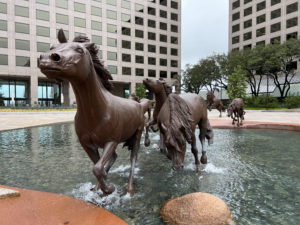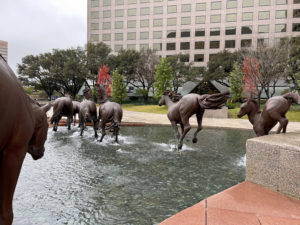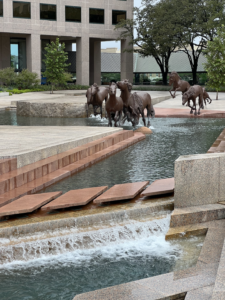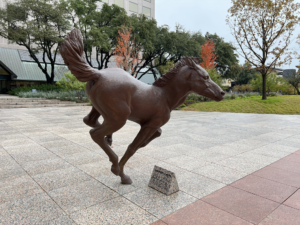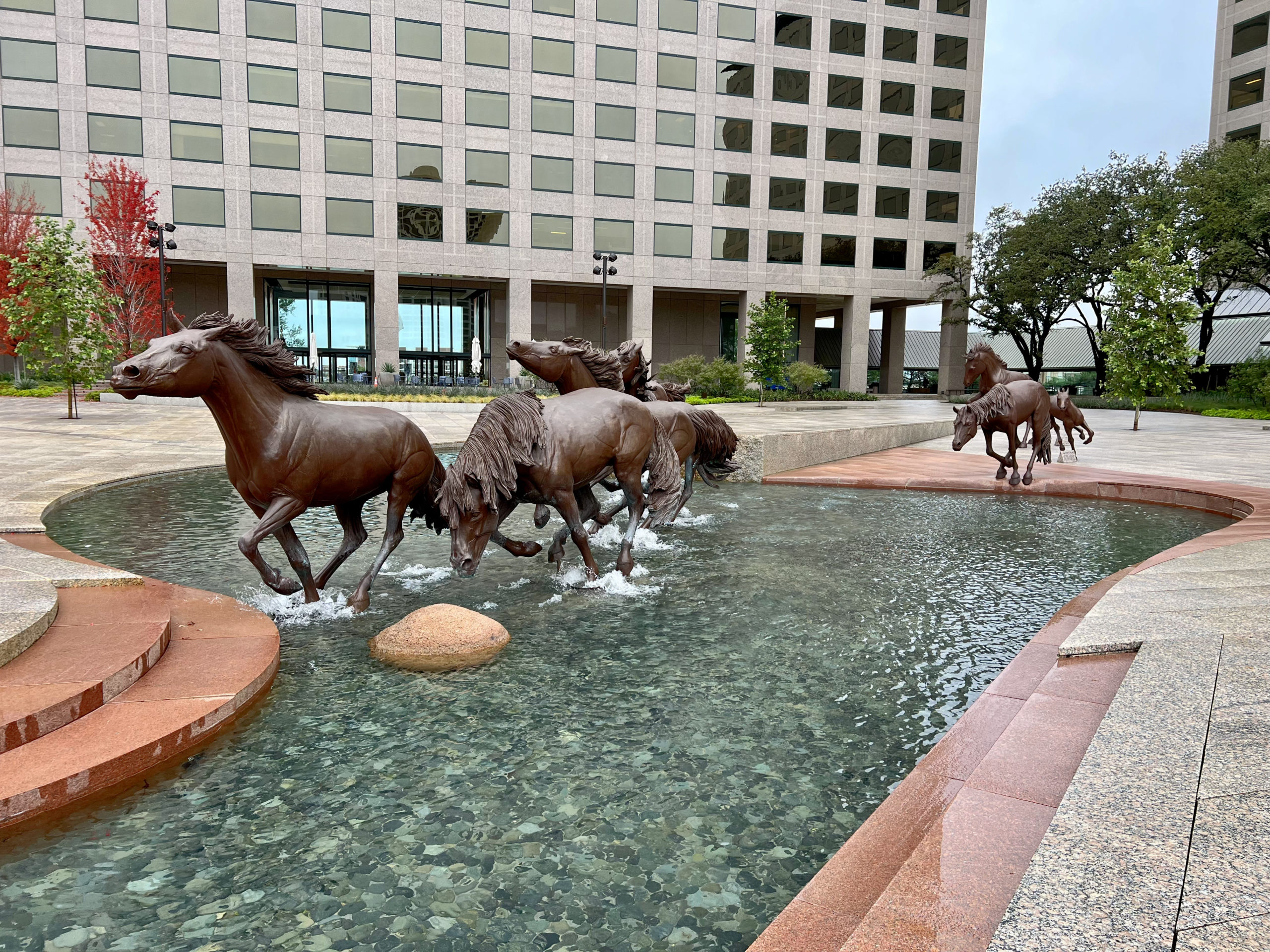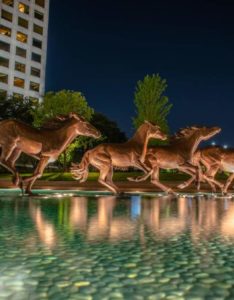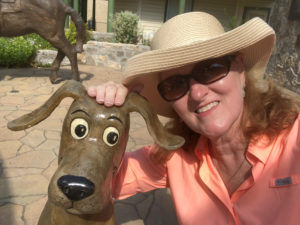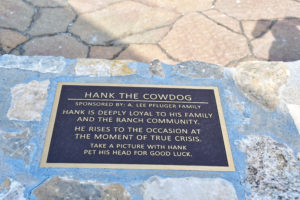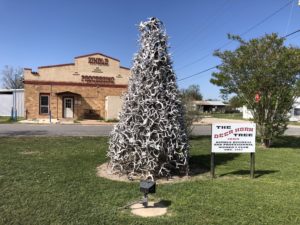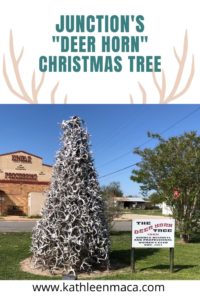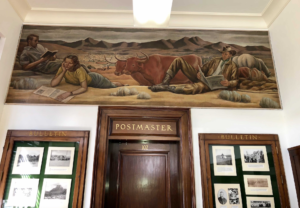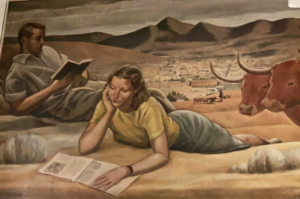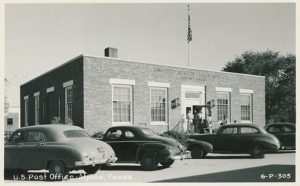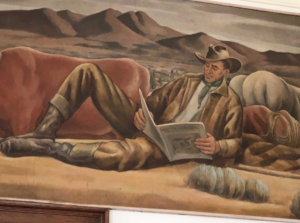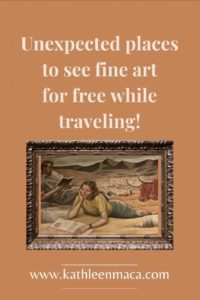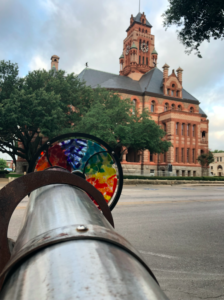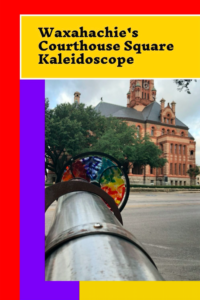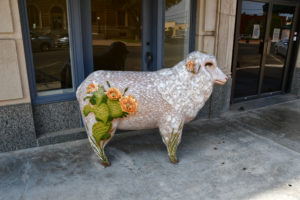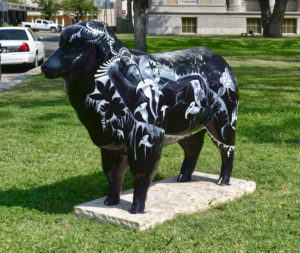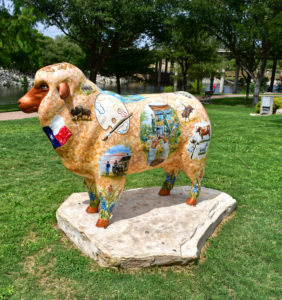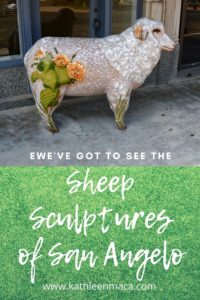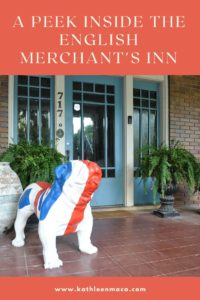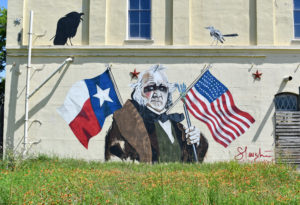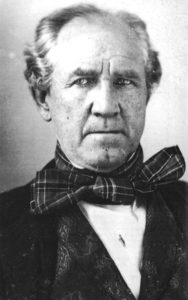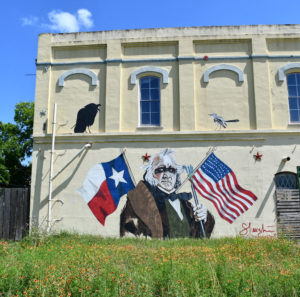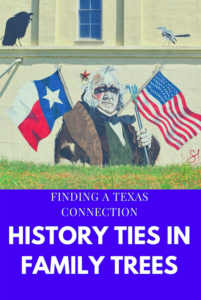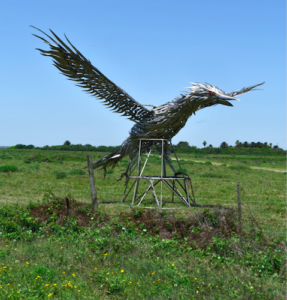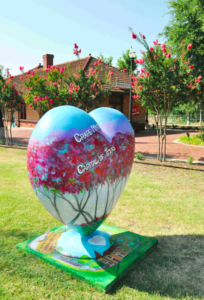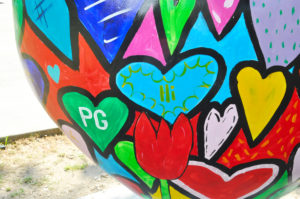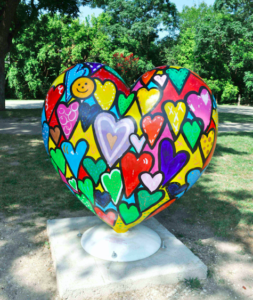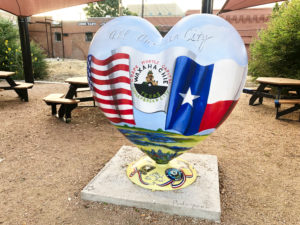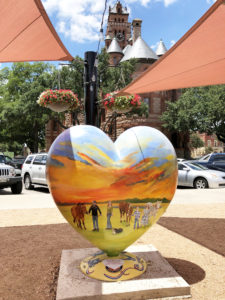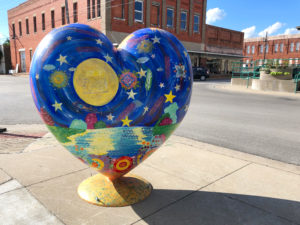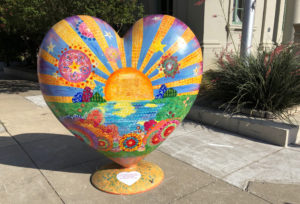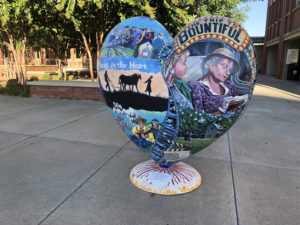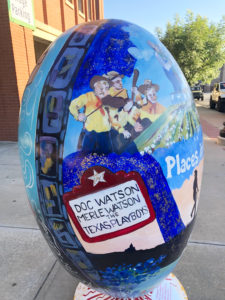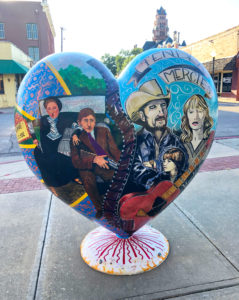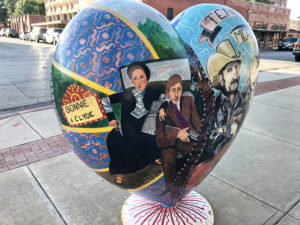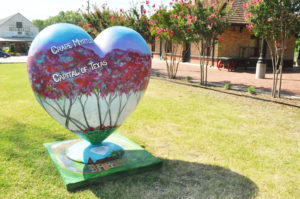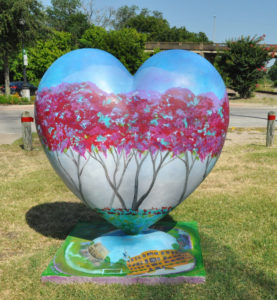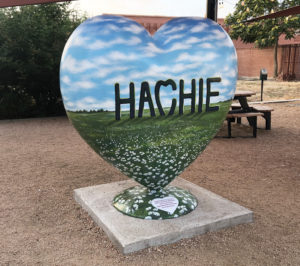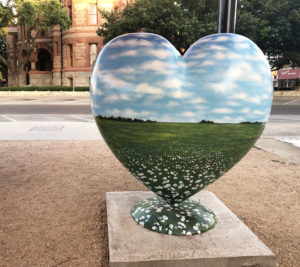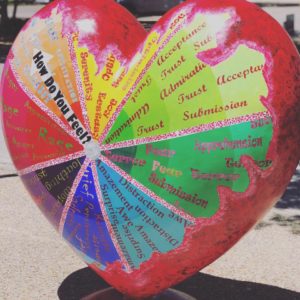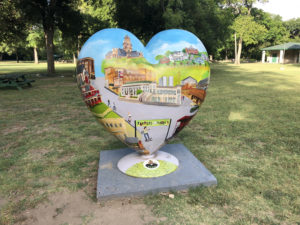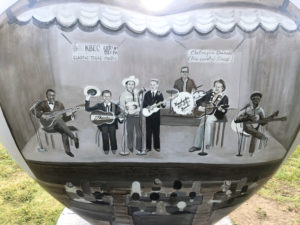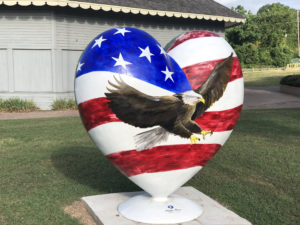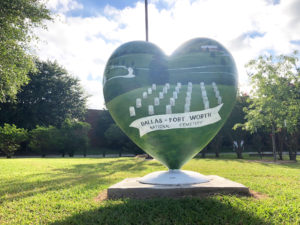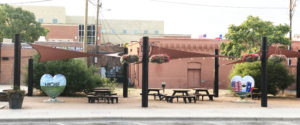Tag: public art
Visit Texas’ Own Hank the Cowdog
“Every ranch pickup ought to have at least one cow dog in the back,
barking at every passing truck.” – Hank the Cowdog, Ranch Life Book No. 1
I had to smile when I read that this Friday is National Dog Appreciation Day . . . because in my world, every day is dog appreciation day!
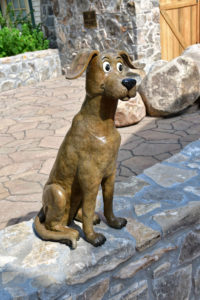 And as a Texan, what better dog to send some appreciation to than the star of the humorous mystery novel series Hank the Cow Dog.
And as a Texan, what better dog to send some appreciation to than the star of the humorous mystery novel series Hank the Cow Dog.
If you aren’t familiar with Hank, you’re in for a treat. This hysterical cow dog, or “Head of Ranch Security” as he prefers to be called, has a slew of doggone fun adventures among other characters that include Pete the Barn Cat, Slim Chance and Sally May – all created by Texas Literary Hall of Fame inductee John R. Erickson.
 The books have sold over 9 million worldwide! Pretty darn good for an old dog! My daughter and I read dozens of them when she was little, and I’ve lost count of how many I’ve gifted to other kids.
The books have sold over 9 million worldwide! Pretty darn good for an old dog! My daughter and I read dozens of them when she was little, and I’ve lost count of how many I’ve gifted to other kids.
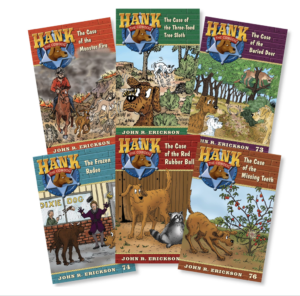 Do you have to be a kid or a Texan to get a kick out of Hank’s stories? Nope! People as far away as Taiwan are fans. But as long as you’re reading one, why not read it aloud to the nearest child? That will brighten both your days!
Do you have to be a kid or a Texan to get a kick out of Hank’s stories? Nope! People as far away as Taiwan are fans. But as long as you’re reading one, why not read it aloud to the nearest child? That will brighten both your days!
Erickson, whose hometown is Perryton, grew up in the Panhandle so his description of characters and written version of a Texas twang ring true. He got his literary start with San Angelo’s Livestock Weekly in the 1980s, mentored by another Texas writer named Elmer Kelton.
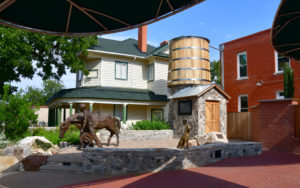 Being a long time fan of these books, if you think I made it a point to stop on a recent trip to San Angelo just to see an ode to Hank . . . well, you’d be right. A bronze statue of the Lone Star State’s beloved canine sits on a ledge in Heritage Park at the corner of West Twohig and Oakes Streets. Sculpted by San Antonio artist Raul Ruiz in 2018, he looks right at home with the other features of the pocket park displayed to honor the ranching and agricultural heritage of the state.
Being a long time fan of these books, if you think I made it a point to stop on a recent trip to San Angelo just to see an ode to Hank . . . well, you’d be right. A bronze statue of the Lone Star State’s beloved canine sits on a ledge in Heritage Park at the corner of West Twohig and Oakes Streets. Sculpted by San Antonio artist Raul Ruiz in 2018, he looks right at home with the other features of the pocket park displayed to honor the ranching and agricultural heritage of the state.
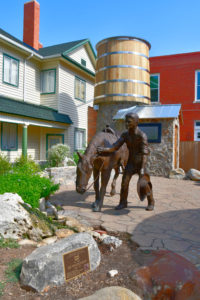 There’s a sculpture of a rancher and his trusty horse, native plants, a vintage cistern system and plenty of space to sit for a spell in the shade of a leaf-shaped overhang that provides an escape from the Texas sun. The park is open to the public daily from 8 a.m. to 8 p.m.
There’s a sculpture of a rancher and his trusty horse, native plants, a vintage cistern system and plenty of space to sit for a spell in the shade of a leaf-shaped overhang that provides an escape from the Texas sun. The park is open to the public daily from 8 a.m. to 8 p.m.
If you want to make a quick visit to one more spot in town honoring Lone Star literature, swing by the mural by Stylie Read of Elmer Stephen Kelton – Erickson’s mentor – author of over 50 western novels. It’s at 118 South Chadbourne Street.
Now that school’s back in session, if your child is looking to add to their library list, they might just want to check out one of the over 70 stories about this scruffy, scrappy hound. The Texas tails…um, tales… are worth howling about.
Junction’s Pointed Christmas Tree
The motto of Junction, Texas is “Land of Living Waters” for a very good reason. About 300 miles of running rivers, natural springs and flowing streams surround the small town.
But one of the features most photographed by passing tourists has nothing at all to do with water. It’s a Christmas tree (that stays up year-round) constructed entirely of antlers of white tail deer.
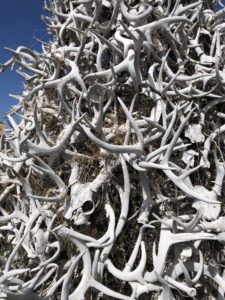 Sitting on Main Street right in the middle of town the tree has likely made drivers of countless cars traveling through the town hit the brakes in a “What was that!” reflex.
Sitting on Main Street right in the middle of town the tree has likely made drivers of countless cars traveling through the town hit the brakes in a “What was that!” reflex.
The unusual roadside attraction was created in 1968 by the Kimble (County) Business and Professional Women’s Club of Junction to celebrate the hunting heritage and history of the area.
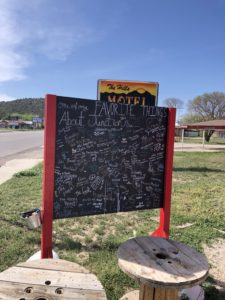 It required hundreds of the antlers to reach its height of 12 feet.
It required hundreds of the antlers to reach its height of 12 feet.
Is it worth driving hundreds of miles to see? Well, um…no. But the nearby scenic overlook and park situated by the river are definitely worth a stop, so why not include the tree while you’re there? And anyone who knows me knows what a kick I get out of quirky roadside attractions.
So “Merry Christmas” from the Antler Tree!
Alpine’s Post Office with a View of the Past
Public art in the form of murals has become so popular in recent years, but they aren’t anything new. The next time you drive through a small town in Texas, stop into the local post office and take a look around. You might just find fine art where you’d least expect it.
Often referred to as “WPA murals,” examples of fine artwork created to enhance public buildings were actually a gift from the government to its citizens.
But, first thing’s first . . . the painting in Alpine wasn’t actually created as part of the Works Progress Administration. The WPA (I’m not going to drown you in details here) was created in 1935 as part of the “Second New Deal” to provide jobs for unemployed men during the depression. Most of the jobs were in construction, building roads, bridges, schools, parks, and airports. There were also artists recruited by the WPA, but they were given fairly free rein in the subjects they painted.
The murals I’d like to introduce you to were created by the Treasury Department Section of Painting and Sculpture which was created a year earlier than the WPA. It was later called the Section of Fine Arts. The goal of this program was to “secure for the Government the best art which this country is capable of producing.” Luckily for us, this art was contracted to decorate federally owned buildings, including hundreds of post offices around the county. That meant that everyone could enjoy fine art in their everyday lives, and the hope was that it would uplift the spirits of citizens during the hard times.
As one writer summed it up, “One boosted paychecks, and the other boosted morale.”
Professional artists (no students or amateurs could apply) entered competitions for Section assignments and were encouraged to visit the individual communities so their artwork would reflect local life or history. And unlike the WPA paintings, Section artists had to have their proposed artwork approved by committee and were limited in the subjects they were allowed to portray.
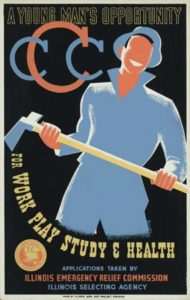
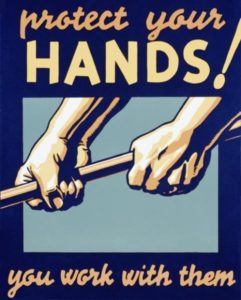 One project of “The Section” placed artists in Civilian Conservation Corps (CCC) camps to create paintings of CCC work and life, and to make safety posters and decorate camp buildings for that project. The Section even provided sculptures to be exhibited at the New York World’s Fair in 1939.
One project of “The Section” placed artists in Civilian Conservation Corps (CCC) camps to create paintings of CCC work and life, and to make safety posters and decorate camp buildings for that project. The Section even provided sculptures to be exhibited at the New York World’s Fair in 1939.
By the end of the program (brought on by World War II) 1,047 murals and 268 sculptures had been created – which is pretty darn amazing. You can still find some of them today, but many have been lost due to building restorations, demolitions or public buildings being bought by private owners.
Anyway….
That’s why I went looking for an example in Alpine on a recent trip through West Texas. The subject especially spoke to me, since it portrays people reading. And nothing makes the heart of someone who writes books happier than seeing someone reading!
It was installed in 1940 inside the town’s new post office which was built by…you guessed it…the WPA.
The building on the corner of 6th Street and Avenue E served as the town’s post office through 2000, when it became the appraisal office for Brewster County. Since that building is open to the public, you can still see the mural in person during weekday business hours. You just have to walk a bit to the left and peer around a few light fixtures and bulletin boards!
 In 1939, a Spanish-American artist Jose Moya del Pino (1891-1969) living in San Francisco entered a TDSFA competition to paint a post office mural in San Antonio. His design depicting Sam Houston and the Alamo didn’t win, but he received a consolation assignment at the new Alpine building. The sketches he submitted with a “View of Alpine” did the trick that time.
In 1939, a Spanish-American artist Jose Moya del Pino (1891-1969) living in San Francisco entered a TDSFA competition to paint a post office mural in San Antonio. His design depicting Sam Houston and the Alamo didn’t win, but he received a consolation assignment at the new Alpine building. The sketches he submitted with a “View of Alpine” did the trick that time.
Jose couldn’t afford to travel to Texas to take a look at the town for ideas, so he asked for suggestions from the local postmistress, who told him about the local college, cowboys and scenery. From there he went to work painting this 4’ x 12’ work in oil on Masonite. He even used a neighbor who happened to own a hat and boots as his model for the cowboy.
When he completed the work in 1940, he accompanied it to Alpine for the installation and unveiling. The depiction of three locals relaxing with books on a hillside, with the Twin Sisters Peaks and Sul Ross State College (now University) in the background were a hit. The only question one local had was why a cowboy would be reading when the cattle were roaming unattended. (A valid question from someone who would probably never let that happen!)
I love the style and subject matter of this painting. It portrays an idealized but beautiful vision of our state, and it was well worth the stop whether you call it a Section or WPA creation.
Now, who’s ready to go out and hunt down a few more these treasures?
Waxahachie’s Courthouse Square Kaleidoscope
Waxahachie courthouse Square kaleidoscope takes looking at the world through rose colored glasses one step further. The Internet active artwork created by Eddie and Mary Elizabeth Phillips sits on the corner of Main and College Street, just across the street from the fabulous Ellis County Courthouse. You overlook it if you’re as entranced with courthouse architecture as I am, but it’s worth looking for! It takes the cardboard kaleidoscopes of our youth to a while new level.
 Built of scrap metal and stained glass, visitors can spin the glass wheel at one end and then look through the triangular opening at the other for a burst of ever changing colors. And the installation is near the corner streetlight it can even be enjoyed at night. (Good thinking!)
Built of scrap metal and stained glass, visitors can spin the glass wheel at one end and then look through the triangular opening at the other for a burst of ever changing colors. And the installation is near the corner streetlight it can even be enjoyed at night. (Good thinking!)
Click these links to see videos of this kinetic beauty in action, and then make a note to give it a spin yourself when you’re in the area!
Were you as fascinated with kaleidoscopes as a kid as I was?
Ewe’ve Got to See This: Painted Sheep of San Angelo
Ewe better believe there’s something, well…sheepish about San Angelo.
No matter where you look, there they are: fiberglass sheep sculptures in every color and design imaginable.
Some cities have cows, horses or pelicans. Here sheep started grazing around town in 2007 as a nod to the town’s past, when it was known as the Wool Capital of the World.
 Each is sponsored (usually by the location where they’re making an appearance) and given a punny name: Happy Trails to EWE, Lambscapes, Don’t EWE Mess with Texas, Lucky EWE, Lamb of God, and more. MANY m
Each is sponsored (usually by the location where they’re making an appearance) and given a punny name: Happy Trails to EWE, Lambscapes, Don’t EWE Mess with Texas, Lucky EWE, Lamb of God, and more. MANY m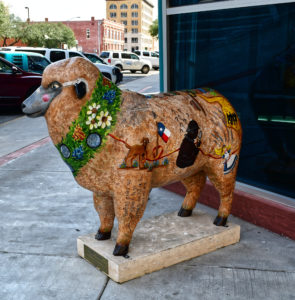 ore.
ore.
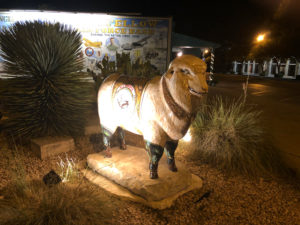 With over 100 sheep in this colorful flock they can keep visitors happily hunting for days.
With over 100 sheep in this colorful flock they can keep visitors happily hunting for days.
If you’re ready to start off on a sheep-tacular scavenger hunt of your own, this list is a great place to start.
Virtual Travel: Waxahachie, Texas
This week we had a quick visit and virtual tour of the English Merchant’s Inn in Waxahachie . . . one of my favorite bed and breakfasts in Texas. If you missed it, you can catch the replay below, then refer to the links below for more fun to be found in this gem of a small town.
Click these links to find more information and photos:
English Merchant’s Inn
Waxahachie Courthouse Folklore
Hachie Hearts
Waxahachie’s Love Lock Bridge
Sam Houston’s Wife and a Kindred Connection
Texan artist Tra Slaughter painted this mural of Sam Houston on the back of a building in downtown Brenham, facing the railroad tracks. If this image of Houston seems odd to you, you may not be familiar with his connection to the Cherokees.
In 1809 at the age of 16, Sam Houston ran away from home in Tennessee and lived among the Cherokees. He was adopted by Chief Oolooteka and given the name Colonneh or the Raven.
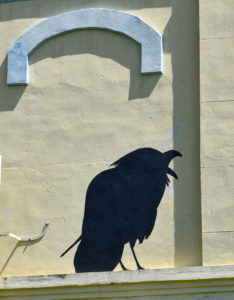 Although I grew up in Texas, I first heard about this other name while attending the university named after this Texan forefather. The name cropped up often around Huntsville in business names.
Although I grew up in Texas, I first heard about this other name while attending the university named after this Texan forefather. The name cropped up often around Huntsville in business names.
While I was learning more about Houston, I found that his Cherokee wife’s name was Talahina “Tiana” Rogers . . . a name that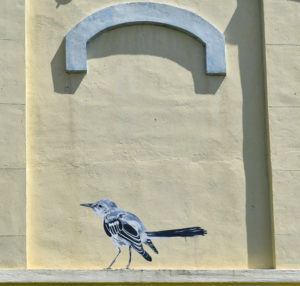 sounded pretty darn familiar to me. Always fascinated with my mother’s Cherokee lineage, I started researching her genealogy when I was just 12.
sounded pretty darn familiar to me. Always fascinated with my mother’s Cherokee lineage, I started researching her genealogy when I was just 12.
Sure enough, Talahina‘s great grandparents William Emory and Mary Suzannah Grant were my seventh great grandparents. So while it is a distant connection, I was happy to learn that I had a personal link to this fascinating woman.
Talahina’s mother Elizabeth was the sister of my 6th great-grandmother Susannah. Both were born in Houston’s home state of Tennessee to William and Mary Emory.
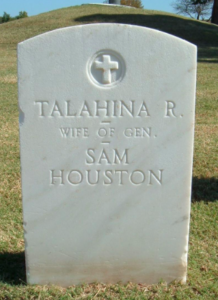
Sam Houston had three wives, but for obvious reasons, this one is a special interest of mine.
This mural is spectacular, and also features an actual raven and a Mockingbird, the state bird of Texas. Art is such a terrific way to relate pieces of history.
Have you done any research on your family tree? You never know what or who you’ll find.
Birdwatcher Alert: A Phoenix on Galveston
What’s 15 feet tall with a 35-foot wingspan and gleams in the sunlight? A metal statue of a Phoenix created by Houston based artist Bob Bacon that now guards the gate of his brother’s Galveston ranch.
Bacon’s creation first appeared in the 2017 Houston Thanksgiving Day Parade, after he created it as a post Hurricane Harvey symbol of hope and recovery.
Since it’s big debut, the statue has been nesting in a warehouse, waiting for its next chance to take flight.
 The onset of the coronavirus pandemic inspired the family to install the phoenix on Galveston Island to once again provide a symbol of hope. The Bacon Ranch is an appropriate home for this particular piece of artwork, since most of the land on the ranch has been set aside as grounds for the migrating birds that pass over Galveston Island each year.
The onset of the coronavirus pandemic inspired the family to install the phoenix on Galveston Island to once again provide a symbol of hope. The Bacon Ranch is an appropriate home for this particular piece of artwork, since most of the land on the ranch has been set aside as grounds for the migrating birds that pass over Galveston Island each year.
The family welcomes visitors to pull along the side of the road to get a close look and photos, but asks that no one trespass beyond the fence.
To visit, travel west from Galveston on FM 3005 past Jamaica Beach, and look on the north side of the road.
No binoculars required!
Waxahachie: Straight from the Heart
If you’re looking for a place with heart . . . you’ll want to add Waxahachie to your travel list.
The “Hachie Hearts Trail” project was initiated as a part of the city’s “A Place in Your Heart, Texas” campaign in this charming town. Large hearts (locals call them “puffy hearts”) decorated with different by artists have been installed around town as public art.
Besides just being enjoyable as to find a view, the hearts can present a fun activity for families or groups. Make it a challenge to find all of the hearts. If you’re in a group, it would be fun to take a selfie with each of the hearts, and the first group back to an agreed upon meeting spot wins.
And if you make that meeting spot Farm Luck Soda Fountain on the courthouse square (YUM!), everyone wins!
“Hearticulture,” appropriately covered with hearts, was painted by Michael Poston and Jenny Galbrath
“All-American City” by Julie Law
“Here Comes the Sun” by artist Leah Lawless-Smith
The psychedelic sunrise was sponsored by the staff of the local Sun Newspaper. Look for hidden images on both sides, chosen by members of the staff.
“Hollywood Texas” by artists Leah Lawless-Smith, Candace Faber, Steve Miller and Mike Duncan. This movie themed heart features scenes from films shot in Waxahachie, like Bonnie and Clyde, Tender Mercies, and Places in the Heart.
“Crape Myrtle Capital” by artists Julie Law
“High Cotton” in Hachie by Damion Brooker is a nod to one of the traditional crops of the area…and probably my favorite heart.
“Emotions” by Leah Lawless-Smith
“Oobie’s Town and Waxahachie All-Star Band” by Julie Law this one at the entrance to Getzendaner Park, backside of heart is a sepia-toned rendition of several of the musicians who have grace the stage of the Chatauqua Auditorium.
and
“Land of the Free” by Gerald Spriggs
Which is your favorite?
After you find all of the Hachie Hearts, stop in at the County Museum on the square and take a look around. They have heart shaped locks for sale that you can write the name of someone you love on, and then attach to either the love lock fence downtown, or the love lock bridge by the old train depot. Leaving a little of your heart behind in Waxahachie . . .
Click here to see a video of Waxahachie’s
Love Lock Bridge

